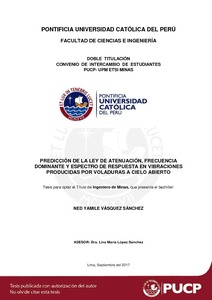| dc.contributor.advisor | López Sánchez, Lina María | es_ES |
| dc.contributor.author | Vásquez Sánchez, Ned Yamile | es_ES |
| dc.date.accessioned | 2018-02-22T15:06:01Z | es_ES |
| dc.date.available | 2018-02-22T15:06:01Z | es_ES |
| dc.date.created | 2017 | es_ES |
| dc.date.issued | 2018-02-22 | es_ES |
| dc.identifier.uri | http://hdl.handle.net/20.500.12404/10182 | |
| dc.description.abstract | El presente proyecto de fin de carrera describe y analiza el estudio integral del efecto de las vibraciones producidas por voladuras superficiales realizadas en el proyecto del “Tercer Juego de Esclusas” ejecutado para la Expansión del Canal de Panamá. Se recopilan un total de 53 registros, data generada por el monitoreo de 7 sismógrafos en 10 voladuras de producción realizadas en el año 2010. El fenómeno vibratorio tiene dos parámetros fundamentales, la velocidad picopartícula (PPV) y la frecuencia dominante, los cuales caracterizan cuan dañino puede ser éste frente a su influencia sobre las estructuras civiles; por ello, se pretende caracterizarlas y fundamentalmente predecirlas, lo que permitirá su debido control. En función a lo expuesto, el estudio realizado consta de dos partes, la primera describe el comportamiento del terreno mediante la estimación de la ley de atenuación de la velocidad pico-partícula a través del uso de la regresión lineal por mínimos cuadrados; la segunda detalla un procedimiento validable para la predicción de la frecuencia dominante y del pseudo-espectro de respuesta de velocidad (PVRS) basada en la teoría de Newmark & Hall. Se ha obtenido: (i) la ley de atenuación del terreno para distintos grados de fiabilidad, (ii) herramientas de diseño de voladuras basadas en la relación de carga – distancia, (iii) la demostración que los valores de PPV se ajustan a una distribución log-normal, (iv) el mapa de isolíneas de PPV para el área de estudio, (v) una técnica detallada y válida para la predicción de la frecuencia dominante y del espectro de respuesta, (vi)
formulaciones matemáticas de los factores de amplificación para el desplazamiento, velocidad y aceleración, (vii) mapa de isolíneas de amplificación para el área de estudio. A partir de los resultados obtenidos se proporciona información útil para su uso en el diseño y control de las voladuras posteriores del proyecto. | es_ES |
| dc.description.abstract | This project work describes and analyzes the comprehensive study of the effect of the vibrations produced by surface blasting carried out in the "Third Set of Locks" project executed for the expansion of the Panama Canal. A total of 53 records were collected, with the data generated by the monitoring of 7 seismographs in 10 production blasts carried out in 2010. The vibratory phenomenon has two fundamental parameters, the peak-particle velocity (PPV) and the dominant frequency, which characterize how damaging this can be compared to their influence on structures, which is why this is intended to characterize and predict fundamentally, that which allows proper control. Based on
the above, the study consists of two parts; the first describes the behavior of the terrain by estimating the attenuation law for peak-particle velocity by using the ordinary least squares regression analysis, the second details a validable procedure for the prediction of the dominant frequency and pseudo-velocity response spectrum (PVRS) based on the theory of Newmark & Hall. The following have been obtained: (i) the attenuation law of the terrain for different degrees of reliability, (ii) blast design tools based on charge-distance ratio, (iii) the demonstration that the values of PPV conform to a log-normal distribution, (iv) the map of isolines of PPV for the area of study (v) detailed and valid technique for predicting the dominant frequency response spectrum, (vi) mathematical formulations of the amplification factors for displacement, velocity and acceleration, (vii) amplification of isolines map for the study area.
From the results obtained, the study provides useful information for use in the design and control of blasting for subsequent projects. | es_ES |
| dc.language.iso | spa | es_ES |
| dc.publisher | Pontificia Universidad Católica del Perú | es_ES |
| dc.rights | Atribución-NoComercial-SinDerivadas 2.5 Perú | * |
| dc.rights | info:eu-repo/semantics/openAccess | es_ES |
| dc.rights.uri | http://creativecommons.org/licenses/by-nc-nd/2.5/pe/ | * |
| dc.subject | Voladuras (Minería) | es_ES |
| dc.subject | Minería a cielo abierto | es_ES |
| dc.subject | Vibración--Control | es_ES |
| dc.title | Predicción de la ley de atenuación, frecuencia dominante y espectro de respuesta en vibraciones producidas por voladuras a cielo abierto | es_ES |
| dc.type | info:eu-repo/semantics/bachelorThesis | es_ES |
| thesis.degree.name | Ingeniero de Minas | es_ES |
| thesis.degree.level | Título Profesional | es_ES |
| thesis.degree.grantor | Pontificia Universidad Católica del Perú. Facultad de Ciencias e Ingeniería | es_ES |
| thesis.degree.discipline | Ingeniería de Minas | es_ES |
| renati.discipline | 724026 | es_ES |
| renati.level | https://purl.org/pe-repo/renati/level#tituloProfesional | es_ES |
| renati.type | https://purl.org/pe-repo/renati/type#tesis | es_ES |
| dc.publisher.country | PE | es_ES |
| dc.subject.ocde | https://purl.org/pe-repo/ocde/ford#2.07.05 | es_ES |







